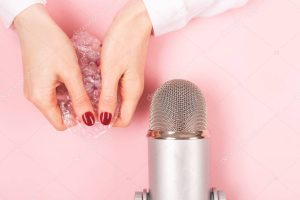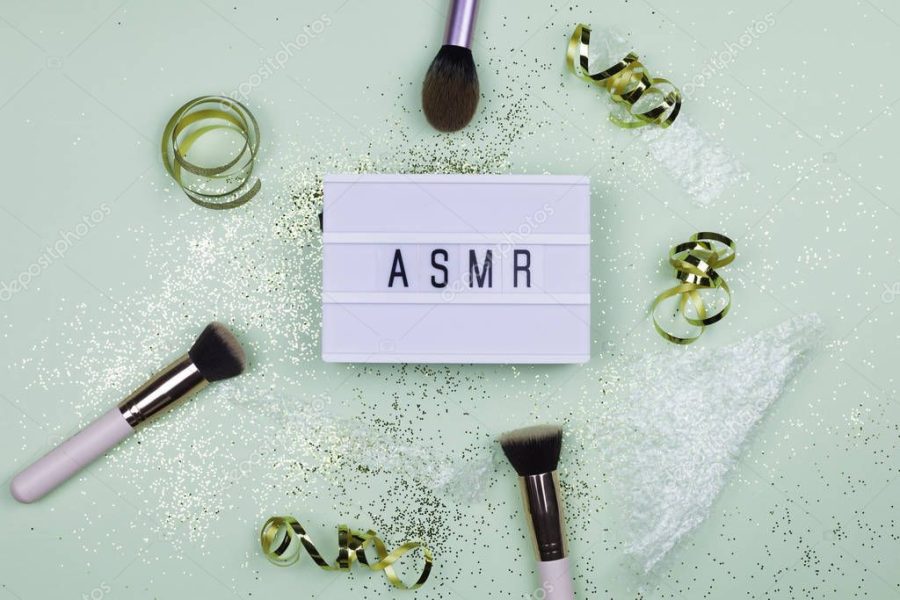ASMR: Are you a Tinglehead?
Taking a Look at the ASMR Craze
February 18, 2022
What’s a Tinglehead?
Does listening to a whisper send a tingle through your scalp? Do you find it soothing to watch someone type on a keyboard in quiet room?
Now, how about the sound of nails clicking gently, the swish or tap of a paintbrush on canvas, or the crinkle of foil as a candy bar is unwrapped?
If these sounds and images give your brain a sparkly, fizzy feeling that relaxes you, then you are… a tinglehead! You are one of the estimated 20% of people that some experts say experience Autonomous Sensory Meridian Response, or ASMR.
But are these real or imagined sensations? There isn’t much research, but fans swear by ASMR, saying the sounds and images in the videos encourage a soothing meditative state that reduces anxiety and lulls them to sleep. The powerful ASMR tingles which surge down the neck, shoulders, and throughout the body are known in the community as,“brain-gasms”
Gazillions of Tingleheads All Over the World
Whatever ASMR actually is, it is globally experienced in over 100 different countries which supports the theory that this it something based in biology rather than culture.
Platforms such as YouTube, has helped ASMR gain popularity with the first video about tingles hitting the internet in 2013. Since then, eager fans have fueled the growth of millions of ASMR clips featuring soft whispers and calming, repetitive motions.
One video, with over 13 million views, features beautifully manicured nails stroking or tapping objects next to a microphone. Other sounds said to trigger tingling are people eating crunchy foods like pickles, paper tearing, water dripping, hair brushing, humming, chewing, buzzing and purring.
As expected, advertisers have also taken notice. Big brands such as McDonalds, KFC, and the NFL (per the Super Bowl in 2019), featured ASMR.
 Understanding “The Tingle”
Understanding “The Tingle”
Craig Richard, founder of ASMR University, a website dedicated to understanding and researching the strange sensation, has done one of the few scientific studies on the topic using functional MRIs to study reactions in the brains of people who have self-identified as tingleheads.
He found that the part of the brain that lit up with an episode of ASMR was in fact, the reward center. That’s where the feel-good hormone oxytocin, also known as the “love or trust hormone,” is produced and is known to be the same part of the brain that becomes addicted to drugs, such as cocaine and heroin.
University of Winnipeg professor of psychology Stephen Smith has also studied the personalities of people with ASMR, and found them to score high in the personality trait ‘openness to experience’ and were more receptive to specific types of physical, auditory, and visual experiences than others.
In another study, Smith used electroencephalograms, or EEG machines, to measure the activity of groups of neurons in the brains of people who say they experience ASMR. Smith found that when people first began to experience tingles, there was a sudden surge in alpha waves, which show a state of wakeful rest. Alpha waves are associated with meditative experiences and this would suggest that what people describe as ASMR is fairly similar to a relaxing meditative experience.
A Feeling of Safe Connection
Many believe that there is a calming effect of ASMR that brings tingleheads back again and again for more. People love the deep sense of relaxation they feel especially after someone who conducts an ASMR speaks in a caring, soothing manner.
It’s similar to the feeling of sitting down on a couch with someone you love, one you feel at home with. When we feel safe with someone, we tend to relax. Usually, videos tend to calm the viewers by reassuring them by saying ‘Hey, it’s OK. I’m here for you. You’re safe. I care about you.’
It is convenient in the digital age that we live in today, as ASMR doesn’t have to happen in person, making it easy to access. These videos consist of the person in the camera looking into the lens and acting like they’ve known the other person their whole lives and deeply care about them.
ASMR can be therapeutic; however, it doesn’t replace professional counseling, and in many ways is just as beneficial as getting outside and experiencing nature. In the way it is good for one’s blood pressure to go for a walk to decompress stressors in life, ASMR can be used as a supplement to help relax, as opposed to a main treatment.
Proven to be Beneficial
New studies and research on ASMR continue to prove that it is beneficial to those that experience tingles.
Recently, a study was done by Charlotte Eid and colleagues at Northumbria University in the U.K. Researchers studied 36 volunteers who experience ASMR and 28 non-experiencers to watch a video meant to trigger ASMR.
Both groups watched the video that included a wide range of triggers such as tapping, scratching, make-up applying, and was presented one after another. The responses heavily suggested that ASMR reduced significant anxiety of those who watched the videos, even when they previously were not familiar with ASMR and did not self-identify as tingleheads.
The phenomenon of ASMR has the potential to be both effective and suitable as a clinically- relevant anxiety treatment. It can serve as another tool one’s mental health toolbox along with mindfulness, meditation, deep breathing or cognitive behavioral therapy, as well as an additional option for self-care.
So…. after reading this, do you think you are a tinglehead? Take a poll down below!!















